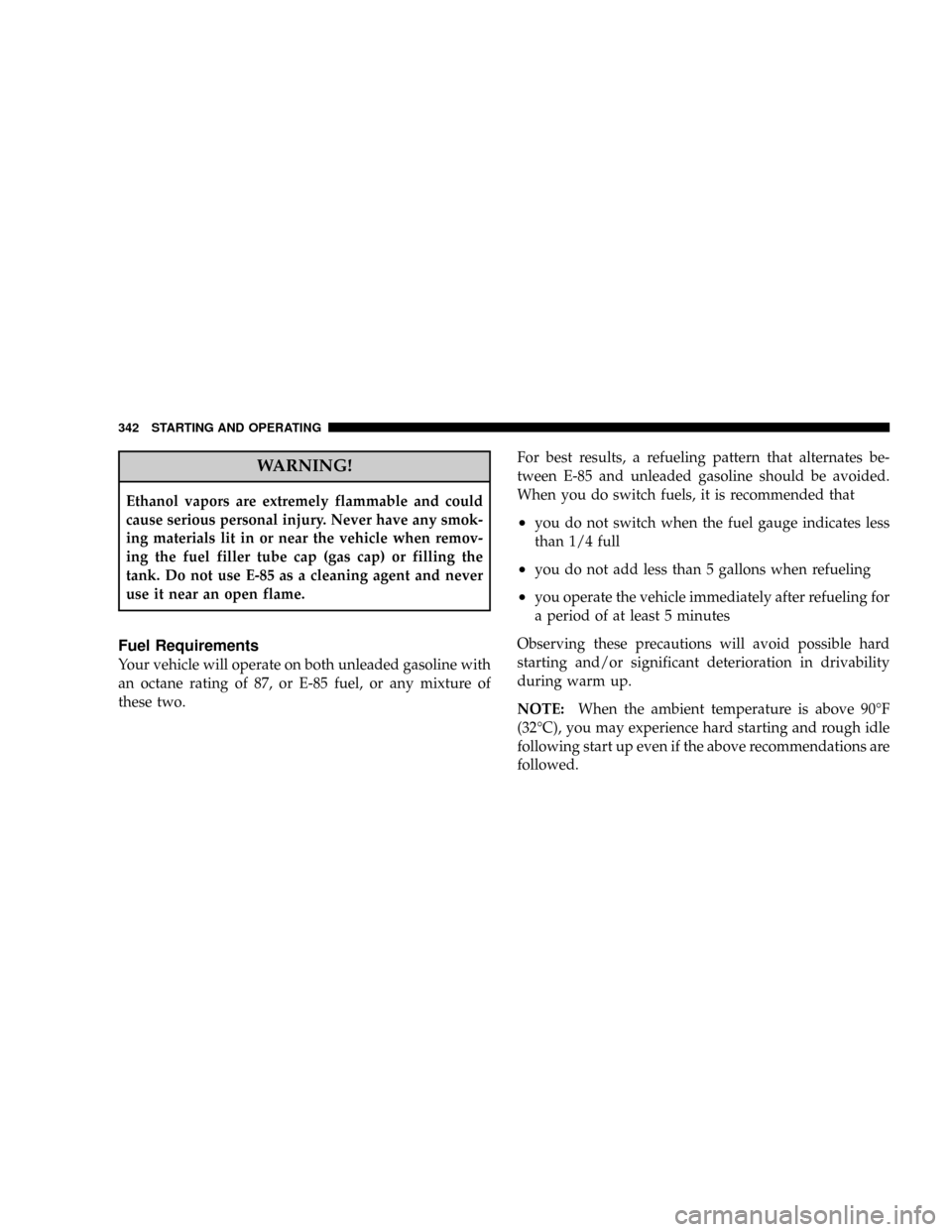Page 189 of 490

before engine start. If the bulb does not come on when
turning the key from OFF to ON, have the condition
checked promptly.
Certain conditions such as a loose or missing gas cap,
poor fuel quality, etc. may illuminate the light after
engine start. The vehicle should be serviced if the light
stays on through several of your typical driving cycles. In
most situations the vehicle will drive normally and will
not require towing.
The Malfunction Indicator Light flashes to alert you to
serious conditions that could lead to immediate loss of
power or severe catalytic converter damage. The vehicle
should be serviced as soon as possible if this occurs.
6. Airbag Warning Light
This light turns on and remains on for 6 to 8
seconds as a bulb check when the ignition
switch is first turned ON. If the light is not onduring starting, stays on, or turns on while driving, have
the system inspected by an authorized dealer as soon as
possible.
7. Anti-Lock Brake Warning Light
This light monitors the Anti-Lock Brake System.
The light will turn on when the ignition switch is
turned to the ON position and may stay on for as long as
four seconds.
If the ABS light remains on or turns on while driving, it
indicates that the Anti-Lock portion of the brake system
is not functioning and that service is required. However,
the conventional brake system will continue to operate
normally if the BRAKE warning light is not on.
If the ABS light is on, the brake system should be serviced
as soon as possible to restore the benefits of Anti-Lock
brakes. If the ABS light does not turn on when the
Ignition switch is turned to the ON position, have the
light inspected by an authorized dealer.
UNDERSTANDING YOUR INSTRUMENT PANEL 189
4
Page 274 of 490

NStarting............................343
NCruising Range.......................343
NReplacement Parts.....................343
mFuel Requirements (Diesel Engines)..........344
mAdding Fuel..........................345
NFuel Filler Cap (Gas Cap)...............346
mVehicle Loading........................348
NCertification Label.....................348
mTrailer Towing.........................351
NCommon Towing Definitions.............351
NTrailer Hitch Classification...............354NTrailer Towing Weights (Maximum Trailer
Weight Ratings)......................355
NTrailer And Tongue Weight..............357
NTowing Requirements..................358
NTowing Tips.........................362
mRecreational Towing (Behind Motorhome, Etc.) . . 364
NTowing ± 2WD Models.................364
NTowing Ð Quadra-Trac I (Single-Speed Transfer
Case) 4WD Models....................364
NTowing Ð Quadra±Trac II /Quadra±Drive II
4WD Models........................364
mSnow Plow...........................368
274 STARTING AND OPERATING
Page 279 of 490

NOTE:
²Use of Climatized ULSD Diesel Fuel or Number 1
ULSD Diesel Fuel results in a noticeable decrease in
fuel economy.
²Climatized ULSD Diesel Fuel is a blend of Number 2
ULSD and Number 1 ULSD Diesel Fuels which re-
duces the temperature at which wax crystals form in
fuel.
NOTE:This engine requires the use ofªUltra Low
Sulfur Diesel Fuel.ºUse of incorrect fuel could result in
exhaust system damage. Refer to ªFuel Requirementsº in
this section for further details on fuel recommendations.
Battery Blanket Usage
A battery loses 60% of its cranking power as the battery
temperature decreases to 0ÉF (-18ÉC). For the same de-
crease in temperature, the engine requires twice as much
power to crank at the same RPM. The use of 120 VAC
powered battery blankets will greatly increase startingcapability at low temperatures. Suitable battery blankets
are available from your authorized Mopartdealer.
Engine Starting Procedure
WARNING!
NEVER pour fuel or other flammable liquid into the
air inlet opening in an attempt to start the vehicle.
This could result in a flash fire causing serious
personal injury.
1. The gear selector must be in the ªNº (Neutral) or ªPº
(Park) position before you can start the engine.
2. Turn the ignition key to the ON position.
3. Watch for the ªGlow Plug Indicator Lightº in the
instrument cluster. Refer to ªInstrument Clusterº in
Section 4. It will glow for two to ten seconds or more,
STARTING AND OPERATING 279
5
Page 328 of 490

Telltale Lightº will turn OFF only after the tires have been
inflated to the vehicle's recommended cold tire pressure
value.
CAUTION!
The TPMS has been optimized for the original
equipment tires and wheels. TPMS pressures have
been established for the tire size equipped on your
vehicle. Undesirable system operation or sensor
damage may result when using replacement equip-
ment that is not of the same size, type, and/or style.
Aftermarket wheels can cause sensor damage. Do not
use aftermarket tire sealants or balance beads if your
vehicle is equipped with a TPMS, as damage to the
sensors may result.
CAUTION!
After inspecting or adjusting the tire pressure always
reinstall the valve stem cap. This will prevent mois-
ture and dirt from entering the valve stem, which
could damage the Tire Pressure Monitoring Sensor.
NOTE:
²The TPMS is not intended to replace normal tire care
and maintenance, or to provide warning of a tire
failure or condition.
²The TPMS should not be used as a tire pressure gauge
while adjusting your tire pressure.
²Driving on a significantly under-inflated tire causes
the tire to overheat and can lead to tire failure.
Under-inflation also reduces fuel efficiency and tire
tread life, and may affect the vehicle's handling and
stopping ability.
328 STARTING AND OPERATING
Page 340 of 490

Carbon Monoxide Warnings
WARNING!
Carbon monoxide (CO) in exhaust gases is deadly.
Follow the precautions below to prevent carbon
monoxide poisoning:
²Do not inhale exhaust gases. They contain carbon
monoxide, a colorless and odorless gas which can kill.
Never run the engine in a closed area, such as a
garage, and never sit in a parked vehicle with the
engine running for an extended period. If the vehicle is
stopped in an open area with the engine running for
more than a short period, adjust the ventilation system
to force fresh, outside air into the vehicle.
²Guard against carbon monoxide with proper mainte-
nance. Have the exhaust system inspected every timethe vehicle is raised. Have any abnormal conditions
repaired promptly. Until repaired, drive with all side
windows fully open.
²Keep the liftgate closed when driving your vehicle to
prevent carbon monoxide and other poisonous ex-
haust gases from entering the vehicle.
FLEXIBLE FUEL (4.7L ENGINE ONLY) Ð IF
EQUIPPED
E-85 General Information
The information in this section is for Flexible Fuel ve-
hicles only. These vehicles can be identified by a unique,
yellow fuel filler cap (gas cap) that statesEthanol (E-85)/
Unleaded Gasoline,and by theFLEXFUELbadge that
will be located on the body of your vehicle. This section
only covers those subjects that are unique to these
vehicles. Please refer to the other sections of this manual
for information on features that are common between
Flexible Fuel and gasoline only powered vehicles.
340 STARTING AND OPERATING
Page 341 of 490
CAUTION!
Only vehicles with the E-85 fuel filler cap (gas cap)
can operate on E-85.
ETHANOL FUEL (E-85)
E-85 is a mixture of approximately 85% fuel ethanol and
15% unleaded gasoline.
E-85 Fuel CapE-85 Badge
STARTING AND OPERATING 341
5
Page 342 of 490

WARNING!
Ethanol vapors are extremely flammable and could
cause serious personal injury. Never have any smok-
ing materials lit in or near the vehicle when remov-
ing the fuel filler tube cap (gas cap) or filling the
tank. Do not use E-85 as a cleaning agent and never
use it near an open flame.
Fuel Requirements
Your vehicle will operate on both unleaded gasoline with
an octane rating of 87, or E-85 fuel, or any mixture of
these two.For best results, a refueling pattern that alternates be-
tween E-85 and unleaded gasoline should be avoided.
When you do switch fuels, it is recommended that
²you do not switch when the fuel gauge indicates less
than 1/4 full
²you do not add less than 5 gallons when refueling
²you operate the vehicle immediately after refueling for
a period of at least 5 minutes
Observing these precautions will avoid possible hard
starting and/or significant deterioration in drivability
during warm up.
NOTE:When the ambient temperature is above 90ÉF
(32ÉC), you may experience hard starting and rough idle
following start up even if the above recommendations are
followed.
342 STARTING AND OPERATING
Page 346 of 490
Fuel Filler Cap (Gas Cap)
The gas cap is located behind the fuel filler door, on the
driver's side of the vehicle. If the gas cap is lost or
damaged, be sure the replacement cap is for use with this
vehicle.CAUTION!
Damage to the fuel system or emission control sys-
tem could result from using an improper fuel cap
(gas cap). A poorly fitting cap could let impurities
into the fuel system. Also, a poorly fitting after-
market cap can cause the MIL (Malfunction Indicator
Light) to illuminate, due to fuel vapors escaping from
the system.
CAUTION!
A poorly fitting gas cap may cause the Malfunction
Indicator Light to turn on.
Fuel Filler Cap Location
346 STARTING AND OPERATING